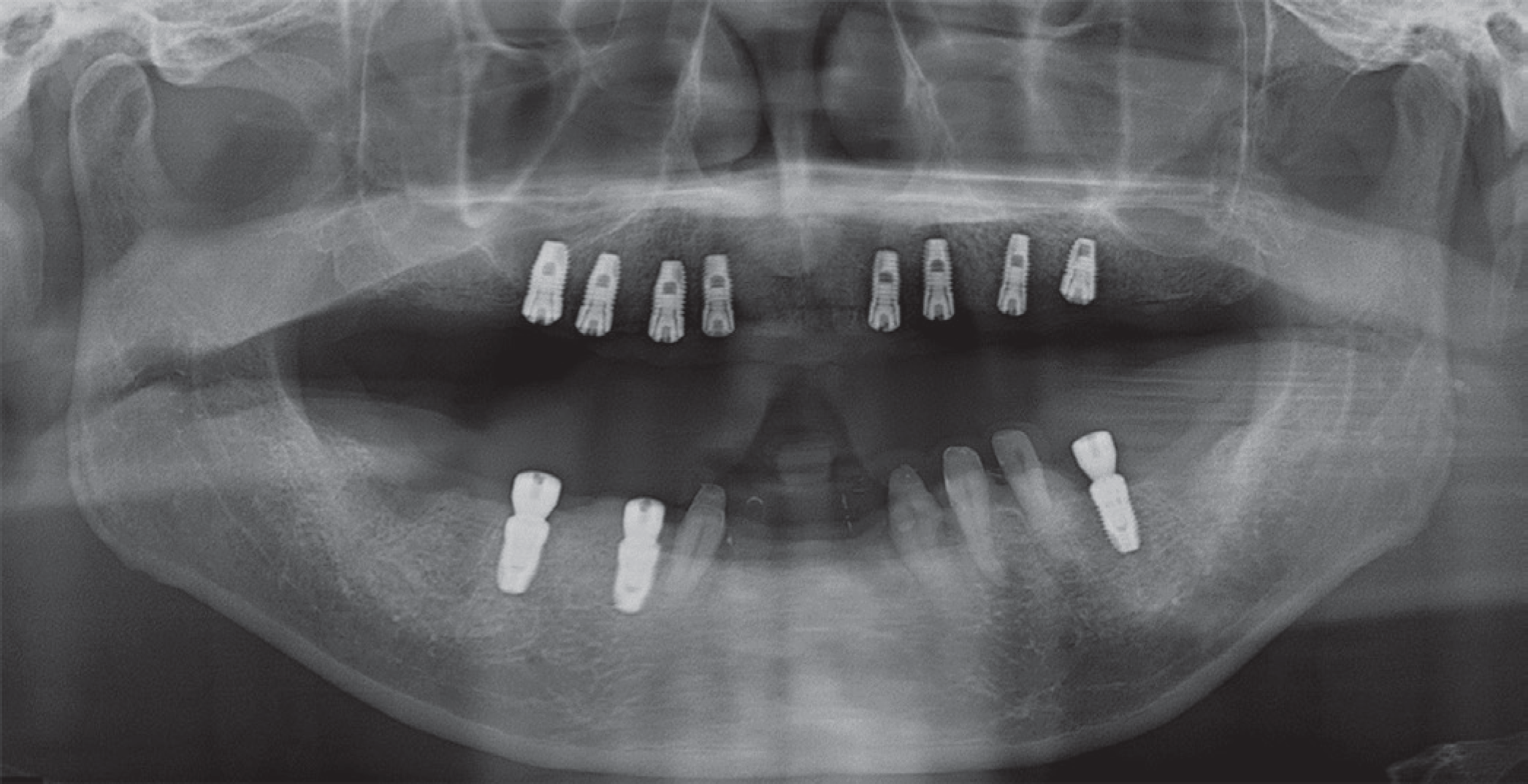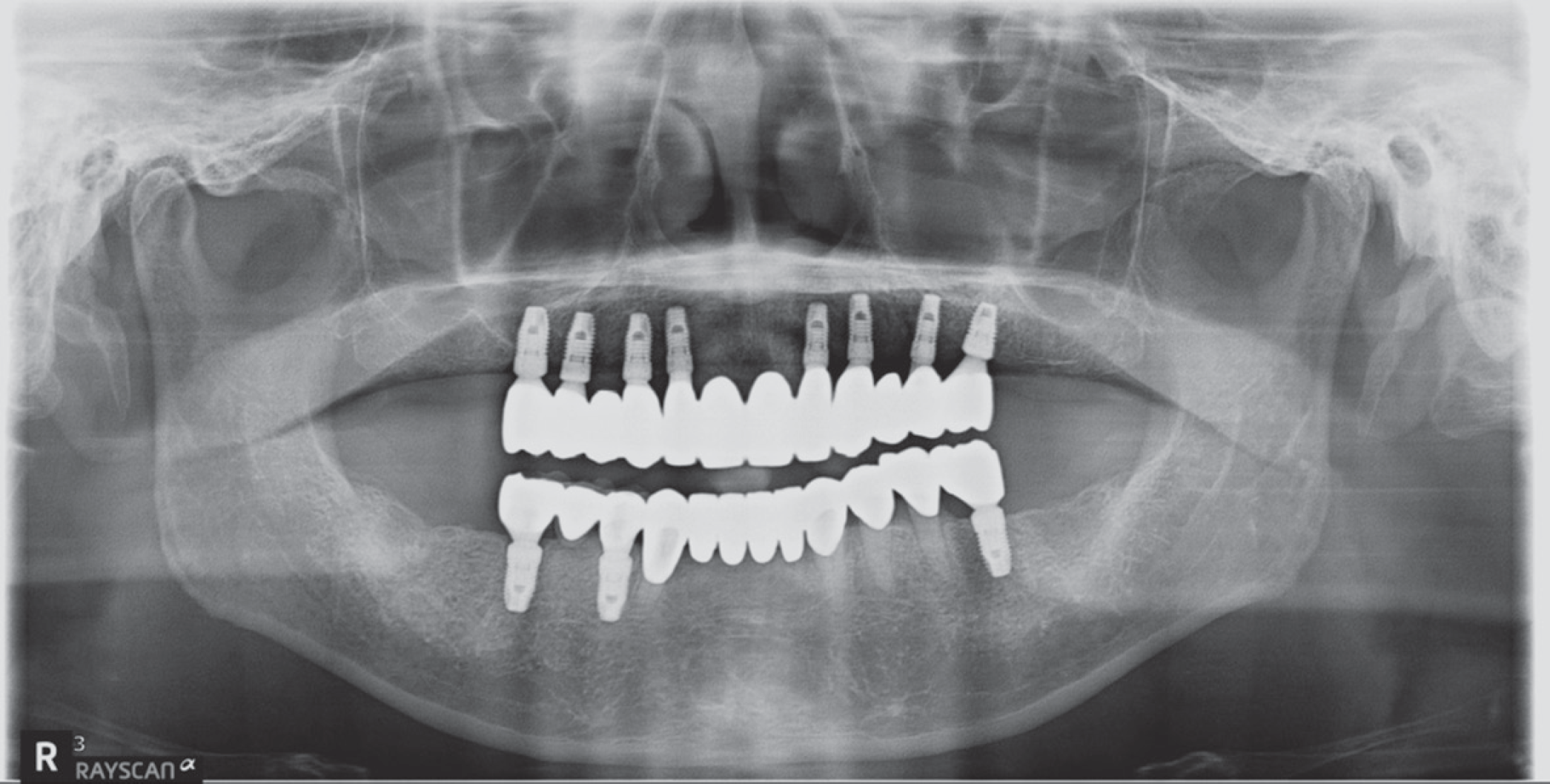Abstract
A conventional approach for the treatment of long-span edentulous areas is the use of removable dentures. However, placing implants in these areas results in superior functional outcomes by increasing the stability, support, and resistance of the prostheses and improving the masticatory efficiency. Treatment modalities utilizing implants can be further classified into either removable or fixed-type prostheses. Several factors such as the amount of alveolar bone resorption, inter-arch relationship, patient preferences, and socioeconomic status should be considered when determining the appropriate treatment approach. Monolithic zirconia has been considered a suitable material for implant-supported fixed dental prosthesis, because of the drastic improvement in its mechanical properties. It exhibits fewer incidences of fracture and chipping of the prostheses, and has greater bulk of material than metal-ceramic crowns and zirconia-veneered ceramics. Moreover, highly translucent monolithic zirconia is also available in the market, and its application is gradually increasing for anterior tooth rehabilitation. The present report describes a patient who underwent full-mouth rehabilitation with fixed dental prostheses (eight upper and three lower implant placements). All teeth, except bilateral mandibular canines and left mandibular first and second premolars, were extracted after the diagnosis of generalized chronic moderate-to-advanced periodontitis of the remaining teeth. The patient reported satisfactory esthetic and functional outcomes during the one-year follow-up visit. (J Korean Acad Prosthodont 2019;57:374-81)
Go to : 
REFERENCES
1.Misch CE. Dental implant prosthetics. 2nd ed.Mosby;2005. p. 3–23. p. 624–39.
2.Zitzmann NU., Marinello CP. Treatment plan for restoring the edentulous maxilla with implant-supported restorations: removable overdenture versus fixed partial denture design. J Prosthet Dent. 1999. 82:188–96.

3.Purcell BA., McGlumphy EA., Holloway JA., Beck FM. Prosthetic complications in mandibular metal-resin implant-fixed complete dental prostheses: a 5- to 9-year analysis. Int J Oral Maxillofac Implants. 2008. 23:847–57.
4.Linkevicius T., Vladimirovas E., Grybauskas S., Puisys A., Rut-kunas V. Veneer fracture in implant-supported metal-ceramic restorations. Part I: Overall success rate and impact of occlusal guidance. Stomatologija. 2008. 10:133–9.
5.Al-Amleh B., Lyons K., Swain M. Clinical trials in zirconia: a systematic review. J Oral Rehabil. 2010. 37:641–52.

6.Denry I., Kelly JR. State of the art of zirconia for dental applications. Dent Mater. 2008. 24:299–307.

7.Abdulmajeed AA., Lim KG., Närhi TO., Cooper LF. Complete-arch implant-supported monolithic zirconia fixed dental prostheses: A systematic review. J Prosthet Dent. 2016. 115:672–7. e1.

8.Armellini D., von Fraunhofer JA. The shortened dental arch: a review of the literature. J Prosthet Dent. 2004. 92:531–5.

9.Rosenoer LM., Sheiham A. Dental impacts on daily life and satisfaction with teeth in relation to dental status in adults. J Oral Rehabil. 1995. 22:469–80.
10.Lindhe J. Clinical Periodontology and implant dentistry. 5th ed.John wiley & Sons;2008. p. 1170.
11.Lee A., Okayasu K., Wang HL. Screw- versus cement-retained implant restorations: current concepts. Implant Dent. 2010. 19:8–15.

12.Lemos CA., de Souza Batista VE., Almeida DA., Santiago Júnior JF., Verri FR., Pellizzer EP. Evaluation of cement-retained versus screw-retained implant-supported restorations for marginal bone loss: A systematic review and meta-analysis. J Prosthet Dent. 2016. 115:419–27.
13.Kim Y., Oh TJ., Misch CE., Wang HL. Occlusal considerations in implant therapy: clinical guidelines with biomechanical rationale. Clin Oral Implants Res. 2005. 16:26–35.

14.Albashaireh ZS., Ghazal M., Kern M. Two-body wear of different ceramic materials opposed to zirconia ceramic. J Prosthet Dent. 2010. 104:105–13.

15.Baldissara P., Wandscher VF., Marchionatti AME., Parisi C., Monaco C., Ciocca L. Translucency of IPS e.max and cubic zirconia monolithic crowns. J Prosthet Dent. 2018. 120:269–75.

16.Bidra AS., Rungruanganunt P., Gauthier M. Clinical outcomes of full arch fixed implant-supported zirconia prostheses: A systematic review. Eur J Oral Implantol. 2017. 10:35–45.
Go to : 
 | Fig. 1.Intraoral photograph at initial visit. (A) Frontal view, (B) Upper occlusal view, (C) Lower occlusal view. |
 | Fig. 3.Determination of the appropriate type of prosthesis. (A) Lateral view with an old temporary denture inserted, (B) Lateral view with a maxillary flangeless diagnostic tooth arrangement inserted, (C) Intraoral view of a maxillary flangeless diagnostic tooth arrangement. |
 | Fig. 5.Implant level impression-taking procedures. (A) Intraoral frontal view with multiple impression copings connected to the implants with resin materials (LuxaCore Z-Dual, DMG, Germany), (B) Outcome of the maxillary final impression. |
 | Fig. 6.Intraoral photograph of provisional restorations. (A) Maxillary occlusal view, (B) Right lateral view, (C) Frontal view, (D) Left lateral view, (E) Mandibular occlusal view. |
 | Fig. 7.Bite-registration procedures. (A) Try-in of maxillary bite jigs, (B) Try-in of a mandibular bite jig, (C) Sectional bite-registration procedure to transfer the inter-arch relationship established during the provisionalization period. |




 PDF
PDF ePub
ePub Citation
Citation Print
Print






 XML Download
XML Download